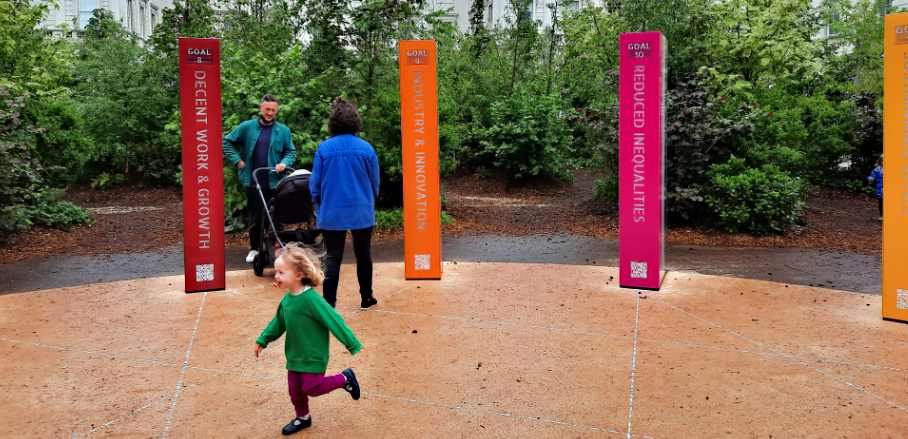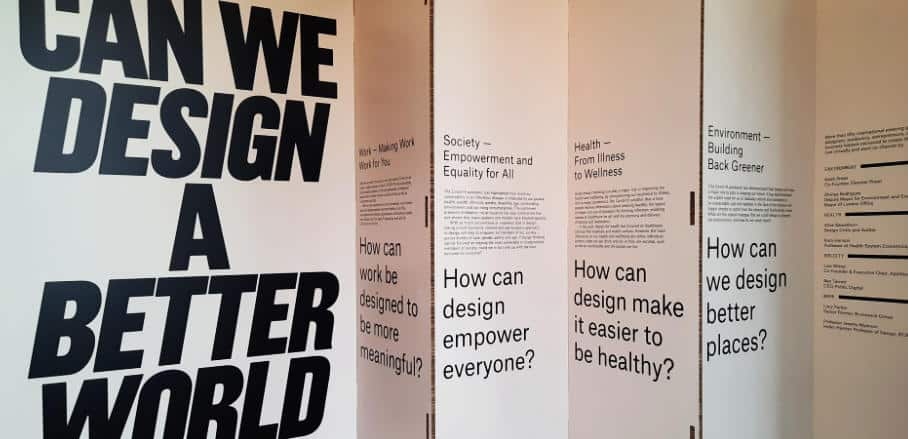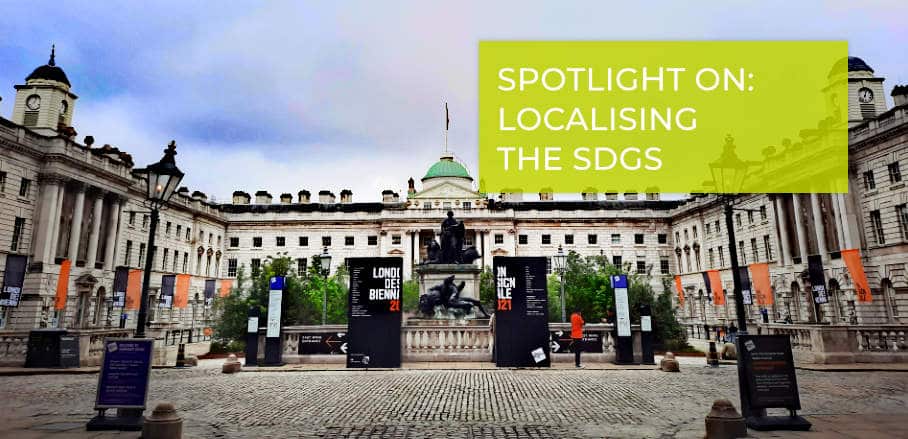Localising SDG 11 Through Inspirational Advocacy
Can design drive positive change? This was the question at the core of London’s Design Biennale 2021. Laura Puttkamer was there and gives you the latest on the future of the urban designs that are here to change the world.
26 country pavilions, several special projects, universities, and a “Forest for Change” took over the majestic Somerset House in central London in June 2021, attempting to answer the question whether we can design a better world. Entering the Biennale, the forest provides a much-welcome sight compared to the sealed urban surfaces we have grown used to. Although Somerset House usually forbids plants, an exception has been made for the artist and activist behind the lush forest, Es Devlin. A staggering 400 trees set on wood pellets and soil fill the courtyard. In the centre of the forest, a clearing with 17 totem-like pillars is visible. Each pillar represents one of the Sustainable Development Goals (SDGs).
Creative SDG Implementation on the Ground
Localising the SDGs means making them more tangible and accessible and understanding what needs to happen to implement them. It is a great feat for the United Nation’s 2030 Agenda that the prestigious Biennale has tackled this question. Each country pavilion shows a solution for positive change, driven by design. Not all of them directly address the SDGs. But one country in particular stands out: India.
India is represented with 160 stories, each of them a voice of Indian design-thinkers who work on sustainability. “In the overwhelming odds faced by developing countries to balance clean water, clean air, clean earth, and forest with urban mass, this project makes a plea for the power of the small, the local, and the connected as a significant alternative to bring a critical mass of ideas that can forge change for 21st century India”, curator Nisha Mathew Ghosh explains. The exhibition in the pavilion shows small-scale ideas of individuals, communities, and organisations, that have the potential for a large-scale impact on sustainable development across the domains of air, earth, energy, forest, and water.

In the centre of the forest a clearing with 17 totem-like pillars. Each pillar represents one of the Sustainable Development Goals (SDGs) © Laura Puttkamer
These domains are each represented by dozens of ideas that can be classified as inspirational advocacy, such as:
- A multilevel crosswalk garden that promotes both clean air and walkability.
- A bamboo toilet that is safe, accessible, affordable, and sustainable.
- The Powerhyde house that creates its own solar energy.
- Chattisgarh State’s innovative forestation policy that incentivises commercial tree plantations while cleaning the air.
- The Indrayani river rejuvenation project that mitigates floods, removes waste, and provides public access.
The Kingston School of Art and the CEPT University in Ahmedabad share a wall to show possibly the most localised and hands-on way of meeting SDG 11, i.e. making cities more inclusive, safe, resilient, and sustainable. A large cross-cut of the Bimanagar housing project in Ahmedabad shows how iterative, sometimes radical steps make it possible to reconfigure the built environment.
In Bimanagar, residents have upgraded the environmental performance of their houses over the last decades. Designed by the internationally recognised Indian architect BV Doshi, the houses cluster around courtyards and allow for constant dynamic change. The research project “How to Build with Time” has followed the steps taken to improve daylight exposure, ventilation, and other aspects. The building project’s experimental arrangement of 54 blocks leaves space to exercise the Right to the City: Residents live, work, and play here. Initially, all 54 blocks looked the same, but now, they are richly diverse. Residents have gone through trials, failures, and successes, led by negotiation. Doshi designed the project to foster adaptation and negotiation by facilitating expansion onto terraces, while mixing apartment sizes and income groups in each block.

London Design Biennale © Laura Puttkamer
Inspiring Change, One Design at a Time
Bimanagar is a living lab for the future. The project shows how SDG 11 can be applied in practice. The research project confirms that architectural strategies and the tactics of inhabitants in combination with favourable conditions provided by urban planning are key for reaching SDG 11. Incremental change can make the urban environment safer, greener, more resilient, and more inclusive.
India’s presence at the Design Biennale has met its goal of providing inspirational advocacy. 160 ideas that are still accessible online can inspire other cities and countries. And the practical example of the Bimanagar housing project holds important lessons for architects, planners, and urban residents alike.
Leaving the Biennale, I feel that its feat to answer the question of how design can drive positive change has been answered in many small ways. And indeed, meeting the ambitious Sustainable Development Goals needs a similar approach. There are no one-size-fits-all solutions. Especially with regard to SDG 11, each city has its own challenges and potentials. However, by looking at the many modular solutions and inspirational ideas presented by India and by other countries during the Design Biennale, we can be inspired. Importantly, we understand what SDGs mean and how they can be implemented. There are no more excuses then – it’s time to get to work!
- Where the Rubber Hits the Road: Localising Climate Action in Cities - 1. March 2024
- Cities and Climate Change: The Buildings Breakthrough at COP28 - 12. December 2023
- Policy and Financing for Net Zero Carbon Buildings: Insights from COP27 - 18. November 2022
